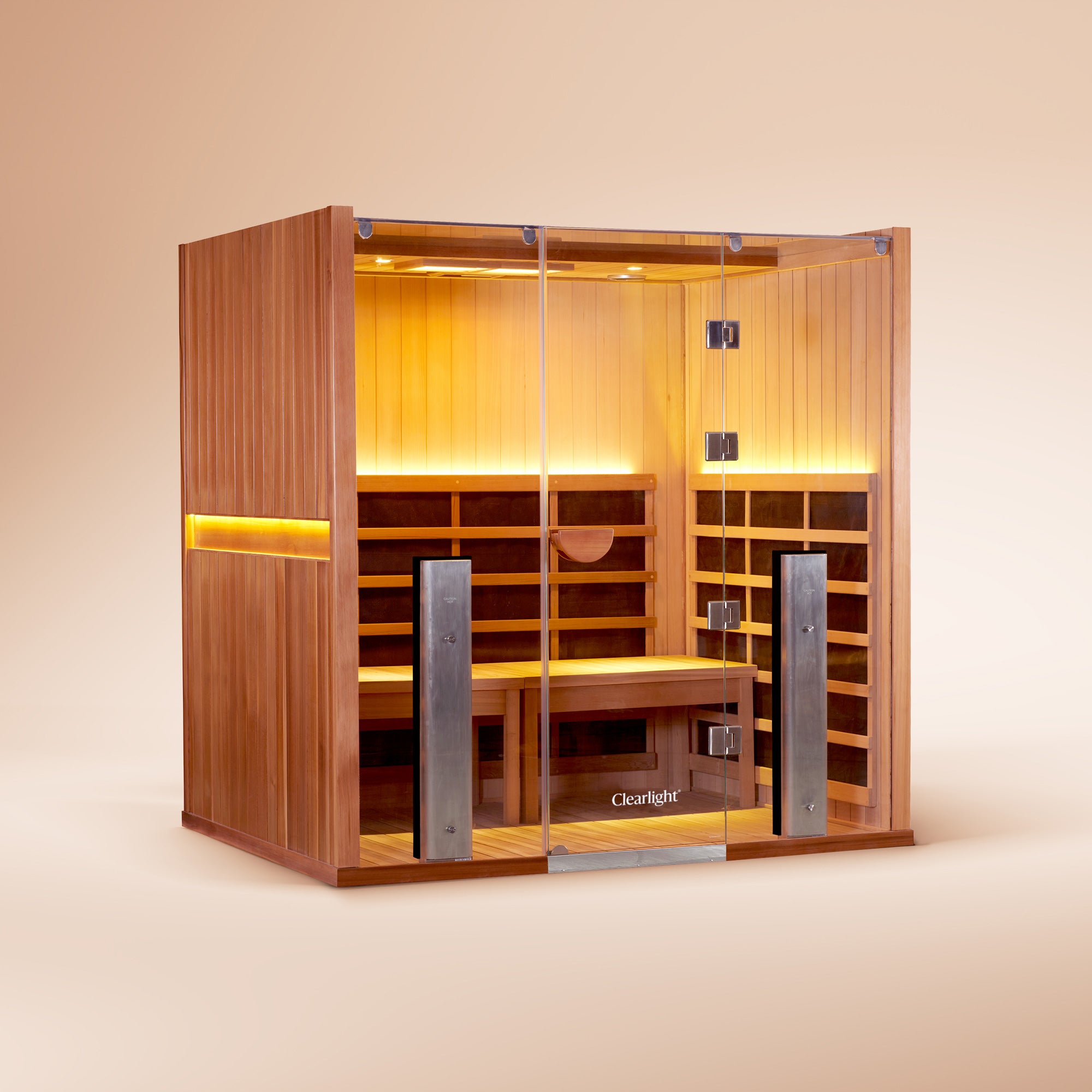Scientists have taken a giant leap in the fight against cancer with an amazing world-first breakthrough! A form of photoimmunotherapy uses near-infrared light (NIR) to target and attack cancer cells, giving hope to those suffering from this disease.
This could be huge news for patients as it introduces another safe and effective way to battle their illness that won't unduly stress out their immune system - potentially making it the fifth major type of treatment available.
So what is photoimmunotherapy, how does it treat cancer, and what does it have to do with infrared saunas? The answer to these questions is all centred around NIR, and in this article we're going to unpack the science and clarify some common misconceptions around the topic.
How is Infrared Sauna Related to Cancer?
When it comes to the relationship between infrared saunas and cancer, there are usually two trains of thought. Can infrared saunas treat cancer, and, can infrared saunas cause skin cancer? The answer to both of these questions are the same. No. Infrared saunas can neither treat nor cause cancer. So where did these misconceptions come from?
The answer may lay with some of the current treatment methods for cancer patients having similarities with the properties or functionality of infrared saunas. The first being whole-body hyperthermia, and the second being near-infrared photoimmunotherapy.
Before we jump into these two known-treatments, let's quickly clarify some questions regarding infrared saunas and cancer cells.

Can the Use of Infrared Sauna Fight Cancer?
There is no evidence to suggest that infrared saunas and their application in recreational settings can have any impact on cancer cells. Infrared saunas utilises a full spectrum of infrared wavelengths, near, mid and far-infrared, to gently heat the core body temperature. This infrared wavelength is safe to the human body in all levels of exposure.
Is Infrared Sauna a Carcinogen?
Speculation of infrared radiation being carcinogenic comes from the relationship of ultraviolet exposure and cancer causing cells. The concept being because we get both UV and IR radiation from sun exposure, and too much sun exposure causes skin cancers, that there is a possibility that IR exposure also causes skin cancers.
A study conducted on mice found that IR exposure did not induce skin tumours, nor did the combination with UV enhance or inhibit the growth behaviour. This study points out that IR is irrelevant to the development of skin tumours, thus showing that IR is a safe and carcinogenic light form.
Can Infrared Saunas be Harmful?
In relation to causing cancer cells, infrared saunas are safe. There is no relationship between IR and cancer causing properties. Yes, there are potential risks to infrared saunas if they're not used properly. Like with most things, moderation is key. Any sauna therapy comes with a risk of dehydration if it's not used correctly. Following common sense and listening to your body will ensure a safe, relaxing, enjoyable and healthy experience each and every time.
Is Far Infrared Sauna Good for Cancer Patients?
There is no development in far infrared light being used in a treatment for cancer cells. Therefore, far infrared is not consider a treatment form in any case. Its application for heat therapy in cancer patients should be advised from a medical practitioner only.
Does Infrared Sauna Prevent Cancer?
There is no evidence that IR radiation exposure can prevent cancer formations. What we do know from an animal study mentioned above is that IR does not cause, nor affect the development of skin tumours caused from UV radiation.
What are the Health Benefits of Infrared Sauna Therapy?
Infrared sauna health benefits include everything from an improved immune function to chronic fatigue and pain management.
The use of far infrared sauna is particularly beneficial at targeting fatty tissue with infrared heat to raise the core temperature and release selective toxicity held in fat cells.
These toxins include heavy metals and have been used in detoxification trials with fire fighters and first responders.
Here is our full list of Clearlight® Sauna benefits:
- Infrared Sauna Weight Loss
- Infrared Sauna Detoxification
- Infrared Sauna Heart Health
- Infrared Sauna Stress Reduction
- Infrared Sauna Skin Benefits
- Infrared Sauna Diabetes Support
- Infrared Sauna Muscle Recovery
- Infrared Sauna Immunity Support
-
Infrared Sauna Joint Pain
Infrared saunas provide a wide range of health benefits and is a suitable alternative or supportive treatment in conjunction with modern medicine for many lifestyle diseases.

Exciting New Research Utilises NIR for Cancer Treatments
A study presented at the American Association for Cancer Research annual meeting has revealed exciting new findings on the clinical trials of photoimmunotherapy (NIR-PIT), a novel cancer treatment. Specifically, it was observed that NIR-PIT had the potential to unleash immune activity against tumours in mice by depleting the tumour microenvironment of certain immune cells that act to restrain the immune response against tumours.
In addition, another study published in Oncotarget showed that NIR-PIT can specifically target cancer cells that express a cell-surface protein that is present at high levels in several aggressive human cancers.
In both cell cultures and mice models, this photoimmunotherapy was found to be effective in reducing tumour size without causing any adverse effect on normal healthy cells or internal organs nearby.
Notably, NIR-PIT harnesses NIR to trigger the release of photosensitive molecules within cancer cells and then convert into toxic molecules which kill cancer cells while leaving normal cells unharmed.
The promising findings from these two studies suggest that NIR-PIT may become a more accessible cancer treatment, as well due to its ability to reduce the number of protective immune cells around tumours.
How Does NIR Kill Cancer Cells in Studies
A 2021 study by Dr Kobayashi into photoimmunotherapy utilised a drug that binds to cancerous cells in the body. The drug is then activated by targeted NIR. The immunotherapy agent in the drug transitions from its Y-shaped form into something completely different - becoming warped and distorted. This causes significant disruption within the cell's outer membrane, leading to liquids bursting through and eventually leading to death in less than a minute after exposure.
What is Photoimmunotherapy and How Does it Work?
Photoimmunotherapy has been hailed as a breakthrough in cancer research, combining the proven benefits of photodynamic therapy with activated T cells and antibodies to target specific parts of tumours. This advanced approach seeks out cancer cells and destroys them while leaving healthy tissue unaffected, while stimulating immune cell responses.
The result is an impressive treatment that not only offers faster results and better targeting than traditional therapies but also reduces unpleasant side effects like damage to healthy cells in neighbouring tissue.
An example of this precision targeting is the first human study which utilised an antibody to target epidermal growth factor receptors to treat head and neck cancer that was approved by the FDA for fast-track testing in 2018. In short, Photoimmunotherapy's combination of therapies provides an accessible and sustainable way forward for successfully treating metastatic cancer.

How is Infrared Light Used in Photoimmunotherapy?
NIR has proven to be an invaluable tool for scientists researching photoimmunotherapy treatments. This is largely due to NIR's capability to create a large absorption at 700 nm, meaning it can stimulate tissues without producing any toxic or ionising radiation when used at the correct energy level.
This property of NIR gives researchers the opportunity to both activate an immune response in certain cases as well as observe how activated T cells (cells that attack infected cells) behave within those cases. Researchers can now observe the functional details of these cells in far more detailed level than before.
Additionally, because NIR only works at specific wavelengths and energies, it has less risk of damaging healthy tissues during treatment, allowing for safer and more efficient photoimmunotherapy methods.
Overall, NIR has revolutionised research into diseases like cancer by providing scientists with a powerful tool for activating and observing T cell responses on a much deeper level than ever before.











Why An Infrared Sauna Anxiety Symptom Management Habit Makes Sense
Infrared Sauna And Psoriasis: The Promising Science